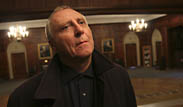Director faces his critics
The students of Religious Studies professor Norman Cornett's course, "Lens of Humanity," welcomed filmmaker Peter Greenaway to class last Saturday, October 23. The director of such outre works as Zed and Two Noughts and The Cook, the Thief, the Wife and her Lover and The Pillow Book was in town for the world premiere of the Tulse Luper Suitcases trilogy at the International Festival of New Cinema. The festival organizers introduced Greenaway to Cornett last year.

Filmmaker Peter Greenaway
Owen Egan
The trilogy is about a consummate collector, adventurer and prisoner -- Tulse Luper -- who was present at key moments of the twentieth century, hoarding objects into 92 suitcases. Tulse Luper also has multivagant web components and pushes the boundaries of film media's latest technology in Greenaway's trademark lush, painterly style.
Greenaway has a solidity about him, even though he's not a big man. Simply clad in a well-tailored black suit, he listened composedly as Cornett read aloud students' reactions, written just after viewing the films. Some were angry, annoyed, bored. Others were awe-struck by the film's broad scope, reverent of its artistry. In a later comment, one yearned for a car chase as a respite from the "product of a madman," before succumbing to "the monsoon of Greenaway."
"Welllll," Greenaway drew out in his richly toned resonant voice, clearly amused."The authors are ideal members of my audience." He then continued to talk of his films and tenets he holds dear as an artist.
Spurred on by the McGill architect professors attending the class, Greenaway discussed the "extraordinary egotism of architects," as portrayed in his Belly of an Architect but confessed that if there is reincarnation, he "would like to enter the world again as an architect." Architects change the landscape; other professions are in their shadow. One can avoid cinema, even music, but we need shelter. To his amusement, after Belly came out he was asked to design a post office in Tallin, Estonia, an offer that he declined.
Greenaway started his career as a painter, a métier he holds high. "I have faith that painters were first [marking a surface] when theoretical man became theoretical man, and that painters will be the last to go down with civilization," he said. "Painters open doors, and miserable philosophers come along afterwards."
He sees painters as being in complete control of their work, yet also being allowed - encouraged even -- to fail. "Francis Bacon said that for one good painting, 99 are thrown away" -- they are more free to push at the boundaries of art, whereas "filmmakers are allowed to make one bad film."
Greenaway aims for as much control as possible in his films, as writer, director and always the editor. He sees the latter as most important, since the role of editor is to go "trawling through the material, finding structure and ideas."
One student was struck by Tulse Luper's own arranging, systemizing, hoarding. Yet "despite his belongings, he never belongs," Cornett read aloud.
"We must find order for our selves, comprehension in chaos," Greenaway responded. "I'm just a clerk, a catalogue maker." His film The Draughtsman's Contract is based on 13 drawings. Tulse Luper on 92 suitcases, Zed and Two Noughts on the nine stages of Darwinian evolution. There's an excitement to lists, though they can be somehow disengaging, he adds. Greenaway sees his films as having a sort of "passionate detachment," like that of a medic at the site of an aircraft disaster.
Ever the clerk, he said there are four tyrannies of the film process: the frame, the text, the actor, the camera. It is the first he rails against most. "There is no such thing as a frame in nature," he said. "The frame doesn't fit retinal characteristics, it's a convenience."
One student asked if Greenaway were concerned that the plentiful use of avant-garde technology in the film would interfere with the audience's relationship to protagonist Tulse Luper. Another student lamented the loss of old-style letter writing of his grandparents' era. Greenaway was surprised by their longing for low-tech tools and their worries about knowledge overload. He observes that the "post-television generation" has learned how to absorb knowledge and images at an increasingly rapid pace. The amount of information flashed before us by CNN in just four minutes has not led to viewers going apoplectic on their sofa, he said. He embraces the latest technologies, as should all artists. " I love the painter Vermeer, who in sixteenth century Delft used a camera obscura. Da Vinci was a technocrat, nineteenth century painters used photography, twentieth century futurists used cinema."
"Ignore modern technology at your own peril," he says. "All technology is very easily usable, understandable. You must banish the idea of a technological demon."
When a student asked how he manages to accomplish so much, Greenaway responded by way of an anecdote. Years ago at a film festival in Rotterdam, a fan approached him and said that as long as Greenaway was practical and didn't make demands involving Elizabeth Taylor and dozens of pigs on a plane, he would finance the rest of his career. The fan was producer Kees Kasander, and they've been a penny-wise team since (the three Tulse Luper films were made for $12 million, total, "Redford's pocket change").
To follow in the auteur's footsteps, it seems one must embrace technology. And it helps to find a patron.
For interactive Tulse Luper webphernalia, go to
www.digiscreen.ca/weblers/tulse/flash.html
www.tulselupernetwork.com
www.tulseluperjourney.com
